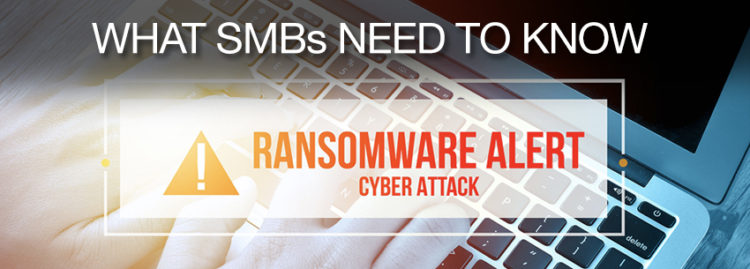Even though ransomware has been top of mind for cybersecurity experts for many years, SMBs are still trying to grasp the threat. While some reports are claiming a decline in ransomware attacks, cybersecurity experts aren’t writing off the security threat, and neither should small business owners.
So what is ransomware?
You’ve probably heard or read the term “ransomware” in the last year or so. Maybe you’re somewhat familiar with it but not 100 percent sure how it can impact you or your business. If you don’t fully understand how this malicious software infects computers, it’s time you and your employees take the time to learn; otherwise, you could end up being one of ransomware’s next victims — and not recover.
Ransomware prevents a user from accessing files or systems by encrypting the data and demands a ransom. Once the user pays the ransom, the attacker — not always — provides the decryption key.
Oftentimes, employees are responsible for inviting ransomware into organizations. Typically, a user unknowingly clicks on a malicious link in an email or message. The action then prompts the ransomware — and it all goes downhill from there. Good luck with regaining access to your systems.
Hackers are attacking SMBs, too
Every day, the news is reporting about a new data breach at another company — typically larger ones, but that doesn’t mean SMBs are immune to cyber threats. Interestingly enough, almost 50 percent of all cyber attacks are directed at small businesses, according to a report released late last year by Score, a network of mentors to America’s small businesses. With regard to ransomware, the study revealed the following: Small businesses were affected by 54,000 ransomware incidents in 2017. The average amount demanded during a ransomware attack? $1,077. When accounting for downtime, lost opportunities, and recovery costs, the average cost to small businesses is $130,000. The first step to stopping ransomware attacks is by keeping your employees informed about threats.
Educating your employees on ransomware is essential to preventing attacks
To prevent a ransomware attack on your organization, first and foremost, educate your employees. They need to understand the seriousness of the threat. A global ransomware cyberattack could cost $193 billion and affect more than 600,000 businesses of all sizes worldwide, according to a report, titled “Bashe Attack: Global infection by contagious malware,” from the Cyber Risk Management (CyRiM) project, a public-private initiative that assesses cyber risks. Educating your employees on cybersecurity annually isn’t going to cut it in an ever-changing threat landscape. Continuing education is necessary, and if you’re not comfortable educating your employees on the topic, look elsewhere.
Leave it to the experts
As a small business owner, you’re already faced with many challenges, including trying to make payroll, generating new revenue streams, and hiring and retention. Staying up to date with what’s going on in the cybersecurity space is challenging for even the companies and specialists in the field, so don’t feel overwhelmed with the amount of information coming at you. Hiring outside IT professionals to assist you with detecting and responding to malicious software could be the solution.
To prevent ransomware threats, a managed services provider (MSP) is going to do two things for your business immediately: deploy security software and backup solutions. In fact, with the right backup and recovery solution (BDR) in place, an SMB can easily recover from a ransomware attack.
Unfortunately, truthfully, ransomware isn’t going away anytime soon. Being aware of what ransomware is and how it infiltrates computer systems is the first step to preventing an attack, but continued education for employees is needed. An outside IT professional can assist you with keeping your business safe from ransomware by monitoring and deterring potential cybersecurity threats.

